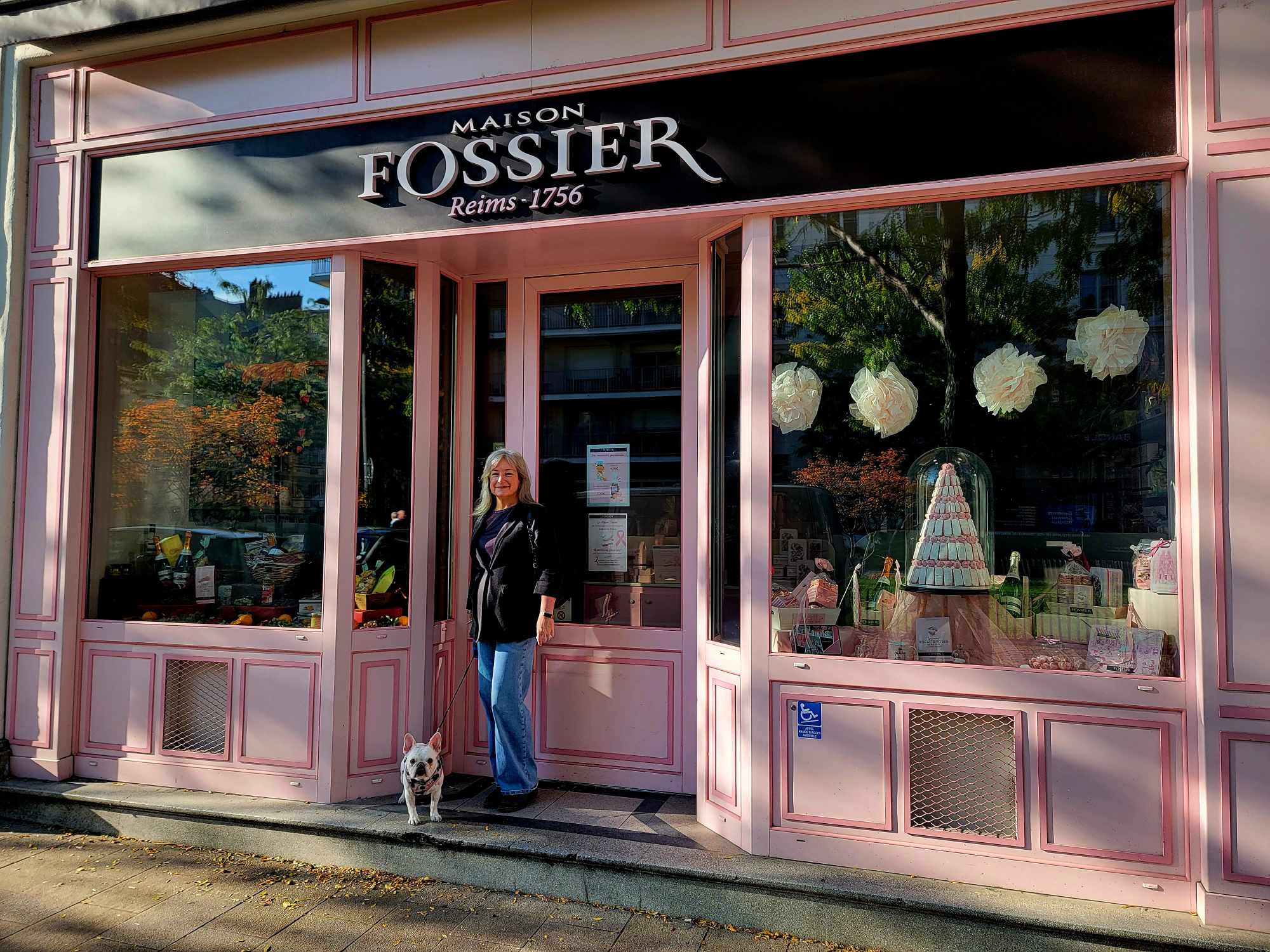What are the best things to do in Reims? First, congratulations for wanting to experience this ancient city and all its wonders, from its historic cathedral, to its incredible museums, and its sparkling champagne culture!
Located in the heart of France’s Champagne region, Reims is a city rich in history, with gorgeous architecture. And the food? Oh la la… Known as the “City of Coronations,” Reims was the historical site for the crowning of twenty-five French kings, making it a monumental site in European history! There are so many diverse, fun, and interesting things to do in Reims, it’s hard to even know where to start. But let’s begin at the beginning.
1) Notre-Dame de Reims Cathedral (Our Lady of Reims)
Allow 1-2 hours here
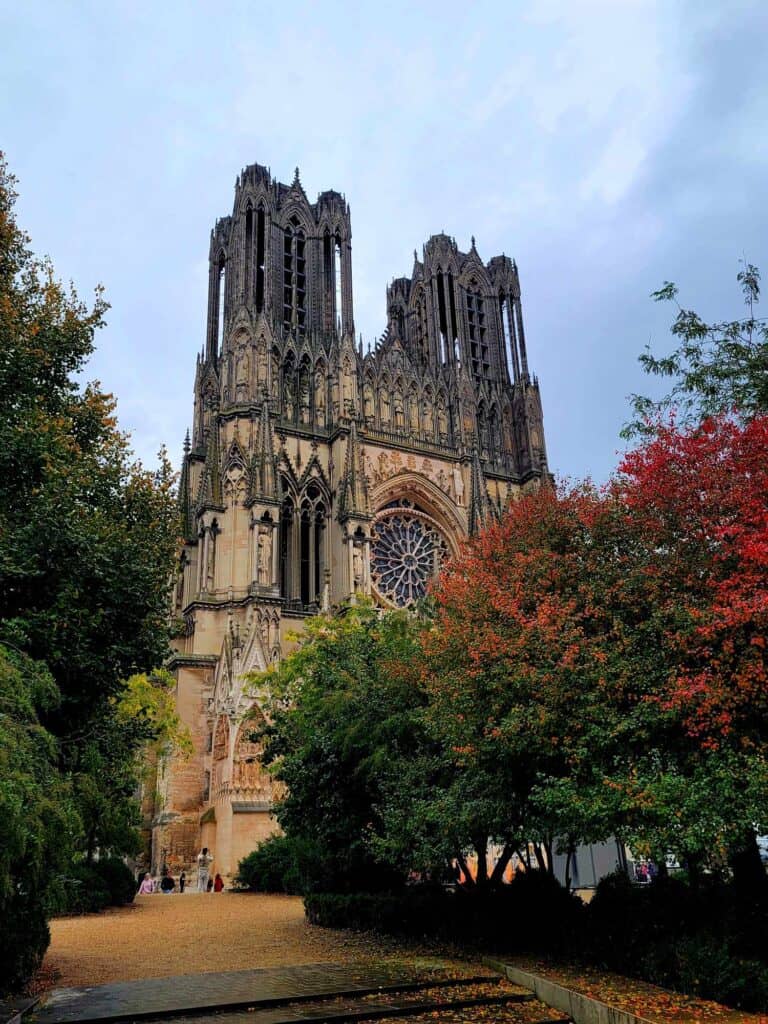
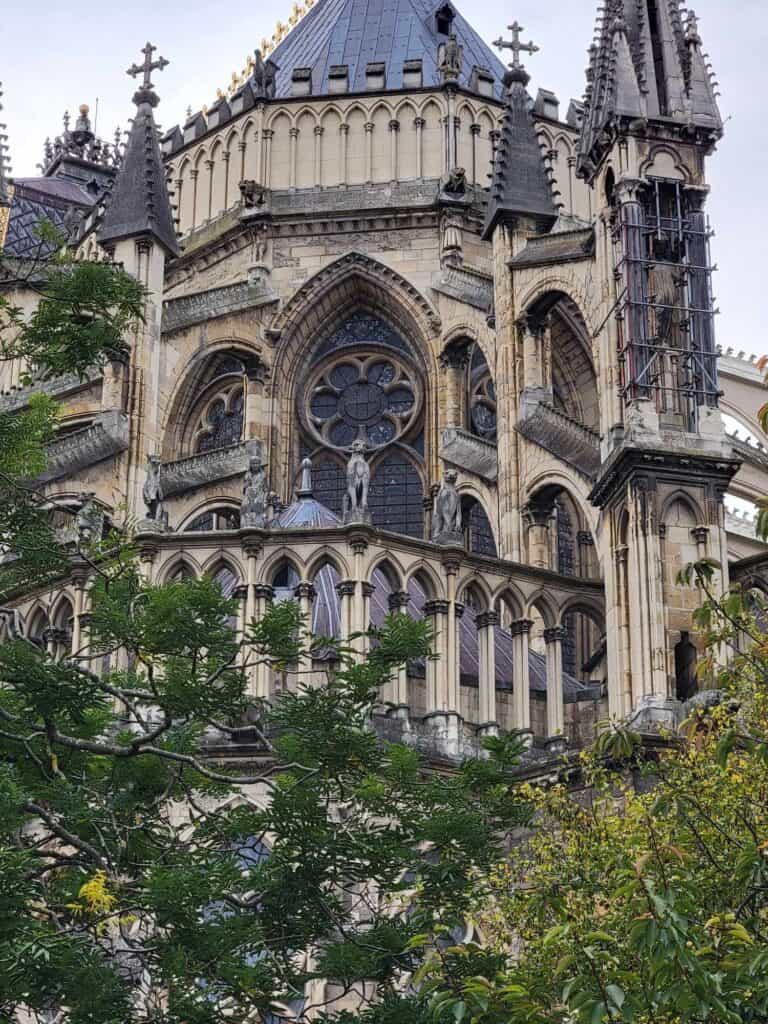
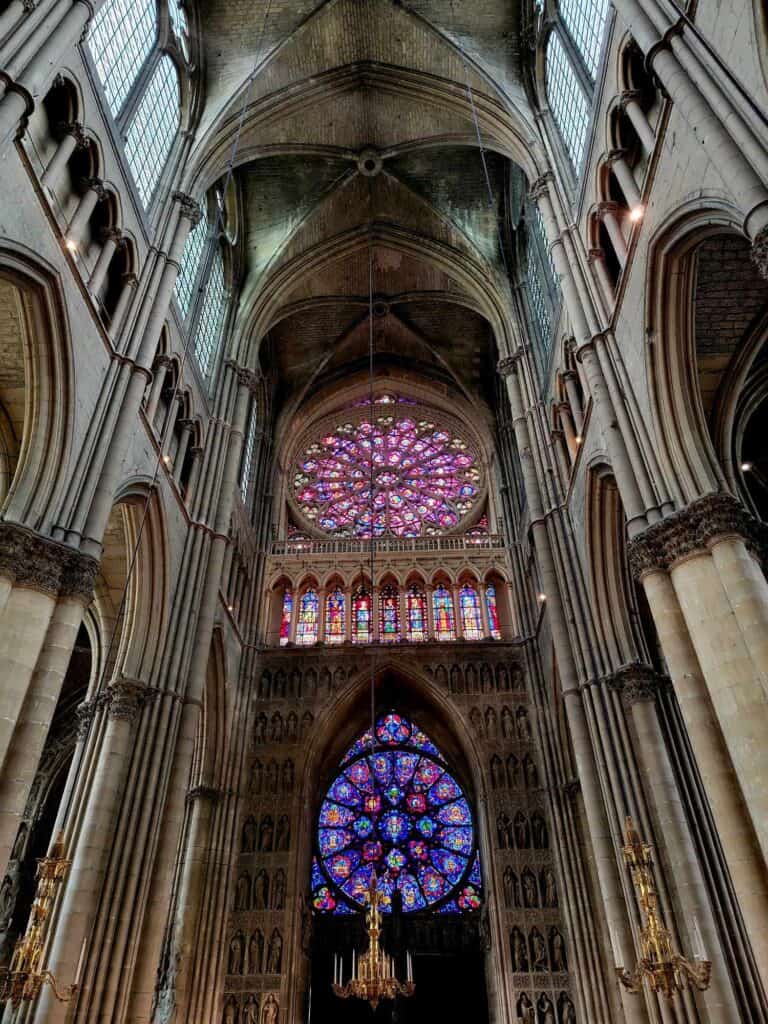
The Notre-Dame de Reims Cathedral is one of the most significant Gothic cathedrals in all of Europe, and is a tremendously important historical site in France. It is the centerpiece of the city, and It has even been designated as a UNESCO World Heritage site. It should definitely be your first stop!
I took a class in college called Cathedrals and Castles of the High Middle Ages (I know, I’m a nerd…) and Reims’ cathedral was on the cover. I looked at it every day – it’s soaring arches, it’s vast airy space, the huge towering panes of stained glass – and it immediately became a bucket list destination for me. It took quite a while for me to make it there, but when I walked inside and felt the cool air and smelled the frankincense and saw the soft light coming through those familiar windows, it was almost overwhelming.
History and Construction
The first building on the site was a Gallo-Roman bath complex built in the 3rd century AD. A series of Christian structures followed. Clovis I, the first king of the Franks, was baptized by Saint Remigius, at or near the site in 496AD. So when I say there’s a lot of history packed into this plot of ground, this is what I’m talking about!
After that, a series of churches were built and rebuilt, and work on the current cathedral began in 1211 after a devastating fire destroyed the previous 9th century Carolingian cathedral. It took over 150 years for the work on what you see today to be mostly completed.
Coronations
Reims Cathedral was the traditional site for the coronation of French kings with a total of 25 of them crowned there, including Charles VII in 1429 with Joan of Arc in attendance! You can see a beautiful bronze statue of her on horseback just outside the cathedral.
Louis XVI was the last king to be crowned in Reims, and France’s last king, period. He met his end at the guillotine a few weeks before his wife Marie Antoinette, earning himself the nickname “Louis the Last.”
WWI Damage and Restoration
During World War I, the cathedral suffered significant damage from German shelling. Fires caused the roof to collapse, and many of the sculptures and almost all of the medieval stained glass was destroyed.
After the war, the cathedral was meticulously restored, including the replacement of the stained glass. Many of the windows were recreated to feature traditional Medieval designs, but there are also some notable and really striking modern windows by Marc Chagall, in his signature azure blue, and German artist Imi Knoebel, that really add a flood of beautiful color to the space.
The Best View in the City
You can also climb the tower of the cathedral for a spectacular view of Reims and the surrounding countryside. But you’ll also get the bonus of being able to examine the outside of the cathedral close up as you go! There are little nooks and crannies, and you’ll see gargoyles, and sculptural and architectural details you might miss from the ground. It’s almost like looking at the building for the first time. The 249 steps are absolutely worth it!
Entry into the cathedral is free, but tickets to climb the tower are €9 for adults.
Unlike many other cathedrals and churches, the interior of the cathedral has many signs, both in English and French, explaining about the history of the cathedral and the artworks inside, which is really nice.
2) The Champagne Houses
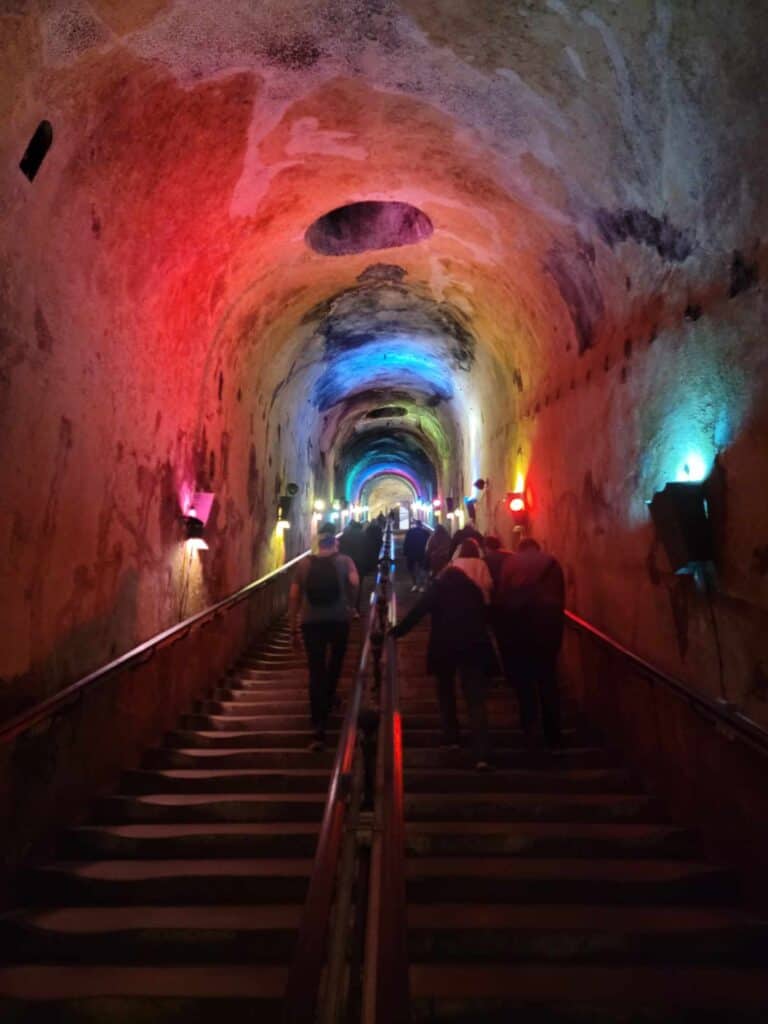
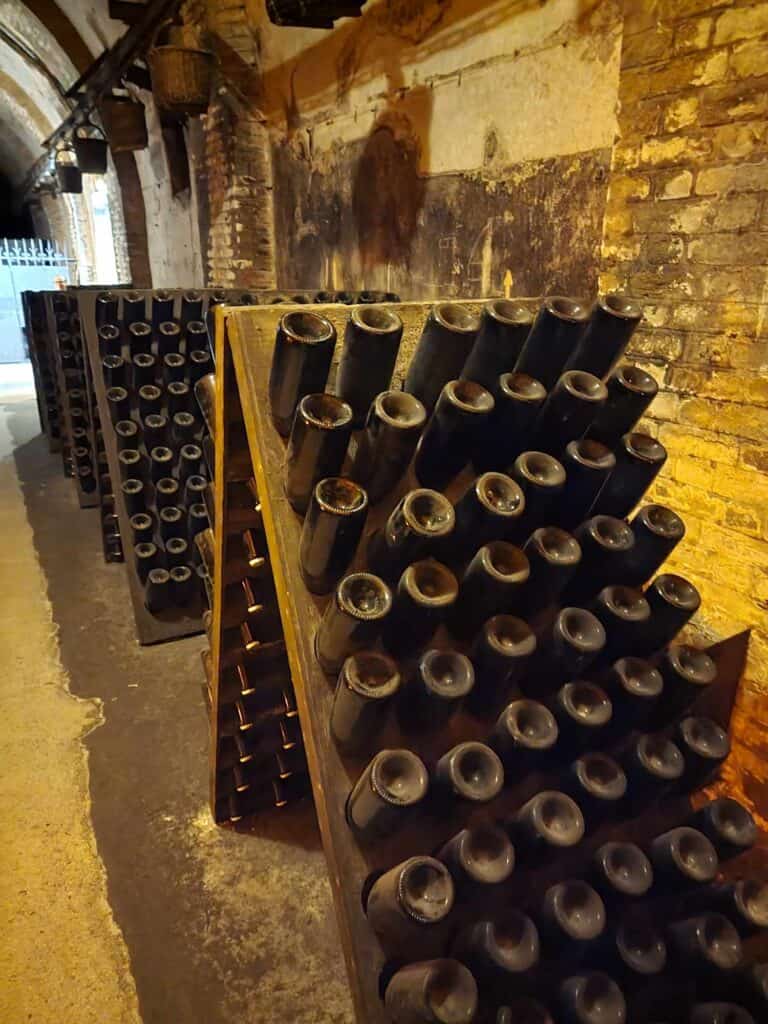
Almost everyone agrees that one of the best things to do in Reims is to indulge in the world’s finest champagne! As you may already know, champagne cannot be called “champagne” unless it is from the Champagne Region of France, and Reims is right in the heart of it! So buckle up and get ready to get your bubbles on!
What is a Champagne House?
A champagne house is a wine producer in the Champagne region that specializes in the production and marketing of champagne. It isn’t like a vineyard because most champagne houses source the grapes used to make their champagne from several different vineyards. These houses, often large producers, work to maintain the reputation and quality standards of the Champagne region.
Champagne houses create signature blends (called cuvées) from different grapes that may come not only from different vineyards and villages but even different vintages, so they can maintain a consistent taste, and quality over time.
Most champagne houses feature grand and beautiful historical estates, tasting rooms where you can sample champagnes, and historic cellars carved into the chalk which underlies the region, where the champagne is stored. Many of these historic caves/cellars are UNESCO World Heritage sites!
What to Expect When You Visit a Champagne House
Visiting a champagne house is a unique and delightful experience that’s kind of a blend of history, art, science, and bubbles! Even if you have only a short time in Reims, squeeze this in if you can.
Visiting a champagne house often includes a guided tour of the cellars, a history of the house, insights into the production process, and tastings of various champagnes. Some of the cellars involve a complex system of chalk tunnels, some even dating back to Roman times!
Most will also display vintage posters and historical photos you can peruse, and some even have art installations. Many houses also offer boutique shopping where you can purchase champagne and related items, and exclusive experiences, such as food pairings or vintage tastings.
Major Champagne Houses in Reims
Reims is actually one of the two main hubs of the Champagne region (the other is Épernay which I’ve written about here), and many world-renowned Champagne houses call it home. You could spend a week doing nothing but visiting cellars and doing tastings, but your memories might be a little foggy!
Here’s the ultimate checklist to get you started in choosing where to go, but suffice it to say that each of these places offers a completely unique experience that is thoughtfully curated by each house. There are similarities of course, but no two are really the same – just like the champagne!
If you have a personal favorite champagne, that’s a great place to start!
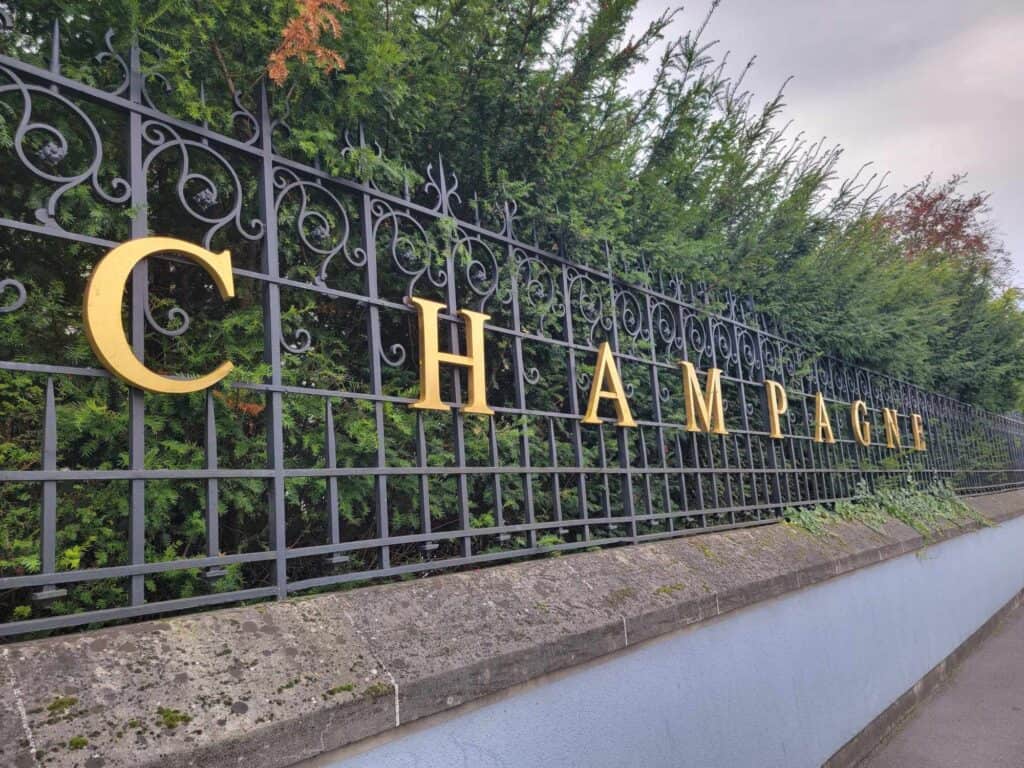
- Ruinart
- Established in 1729, it is the oldest Champagne house in existence!
- Known for its elegant style and historic cellars carved into the chalk that forms the region’s geology.
- Veuve Clicquot
- Founded in 1772, famed for its yellow-label Brut, and my personal favorite!
- Celebrates the innovation of Madame Clicquot, who developed the riddling process still used today in making champagne.
- Taittinger
- Founded in 1734, known for its Chardonnay-forward blends.
- Tours feature a trip through their stunning Roman-era chalk cellars.
- Pommery
- Known for its Brut Nature style and spectacular cellar tours with art installations.
- Founded in 1836, the estate features a striking Elizabethan-style château.
- Mumm
- Famous for its Cordon Rouge Champagne.
- Founded in 1827, offering a blend of history and modern tastings.
- Lanson
- Established in 1760, renowned for its fresh and fruity Champagnes.
- A favorite for royal and ceremonial occasions. How can you go wrong?
- Champagne Charles Heidsieck
- Known for producing richly complex Champagnes and pioneering marketing techniques.
- Established in 1851 (the new kid on the block!), and often praised for its vintage blends.
- Henriot
- Founded in 1808, and specializes in Chardonnay-heavy blends with a focus on elegance.
- Family-owned and one of the smaller, more intimate of the major Champagne houses.
Smaller and Boutique Champagne Houses in Reims
- G.H. Martel & Co.
- Established in 1869, offering more affordable yet still high-quality Champagnes.
- Located in a beautiful and historic 19th-century mansion in Reims.
- De Castellane
- Known for its eye-catching label and traditional production methods.
- Offers a smaller, more personal experience.
- Paul-Etienne Saint Germain
- A boutique Champagne producer offering artisanal blends.
- Located in central Reims, it caters to champagne connoisseurs.
Tips for Visiting: Be sure to make reservations ahead of time, and check the language of the tour/tasting before you book! Consider visiting both large and boutique houses, because they really do offer different experiences and you’ll get the full spectrum. And hey, more champagne is never bad!
3) Musée de la Reddition (The Museum of the Surrender)
12 Rue Franklin Roosevelt, 51100 Reims
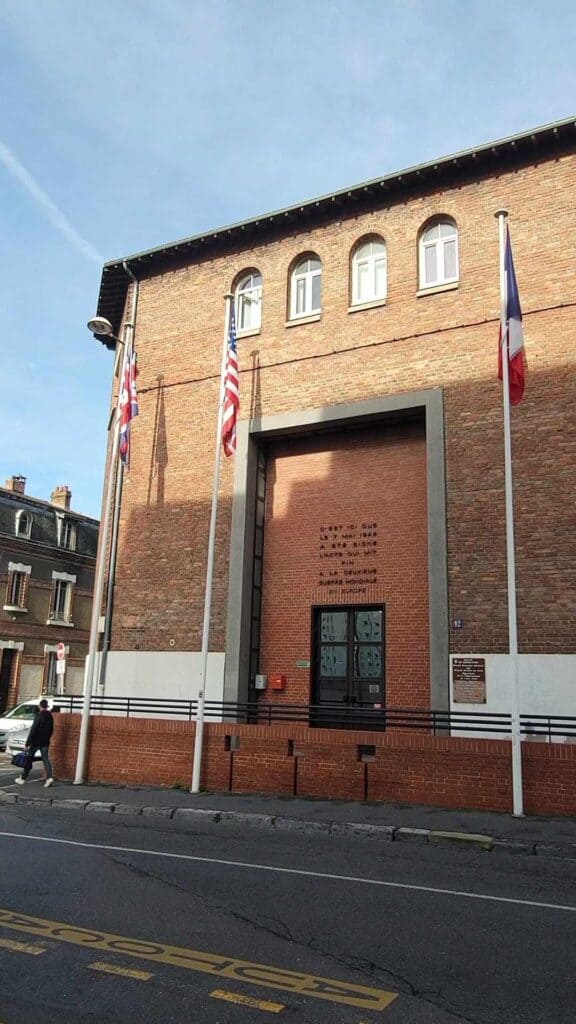
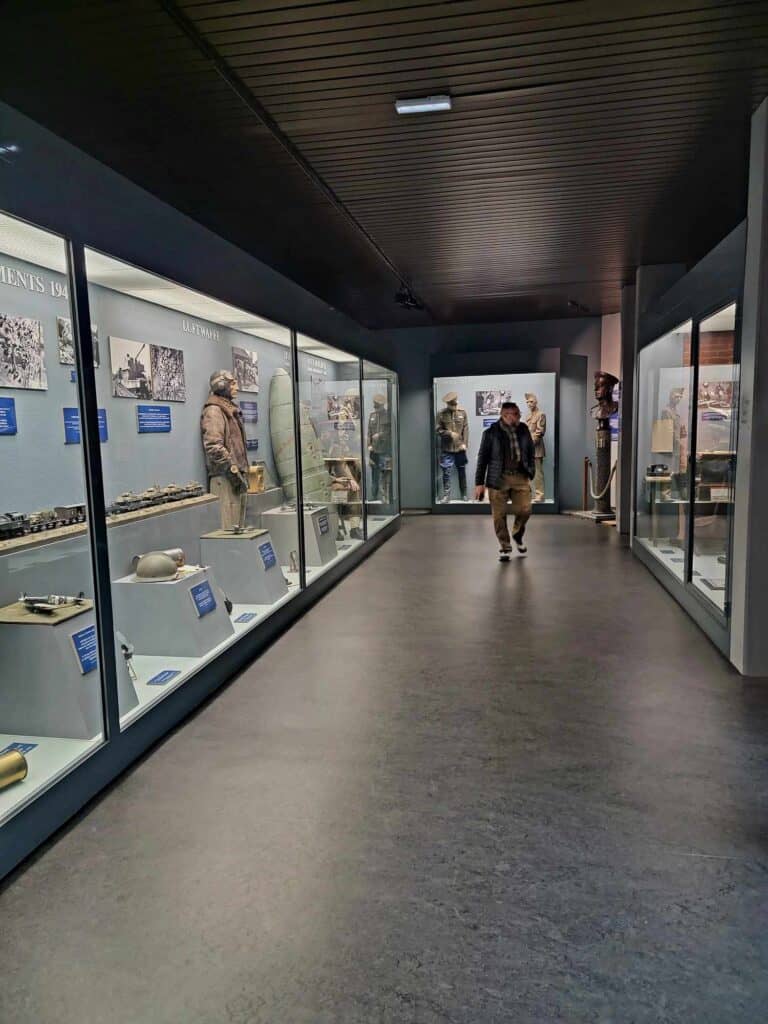
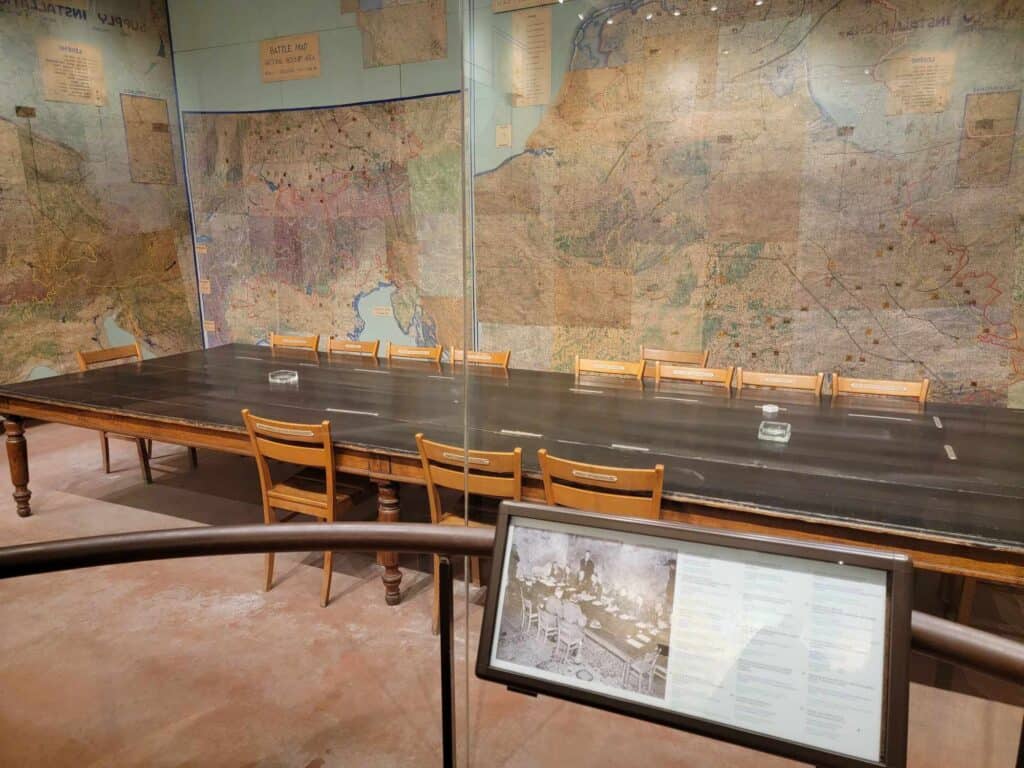
Allow 1-2 hours here
The Musée de la Reddition should be an absolute must for anyone interested in history, and in World War II history in particular. This unassuming red brick building, the site of a former technical school, commemorates one of the most significant moments in the war – the signing of the unconditional surrender of Nazi Germany to the Allied forces, effectively ending the war in Europe.
The Signing of the Treaty
The surrender was signed on the morning of May 7, 1945, in what was then the war room of General Dwight D. Eisenhower’s Supreme Headquarters Allied Expeditionary Force (SHAEF). This former school building, converted into SHAEF’s operational headquarters is where Eisenhower had his command center during the final months of the war.
The Museum Experience
Your visit at the museum will begin with a film that details the ending of the war, the role of Reims in the Allies’ path to victory, and the signing of the surrender documents in the very building you are sitting in.
The film is shown in a little movie theater with comfortable seating and lasts about 15 minutes. You can choose the language for your headphones/audio guide when you check in.
Tickets to the museum are €5 for adults.
The Surrender Room
It was an unexpected goosebumps moment for me to stand in the very room where the Nazis surrendered, looking at the maps still on the wall, the scuff marks on the floor from chairs being pushed out from under the conference table, and to imagine what that day must have been like.
It’s easy to imagine in some ways, because the room has been perfectly preserved with its original furniture, maps, and even communications equipment. It’s a remarkable time capsule of the day fascism in Europe met its defeat. The Surrender Room is definitely the highlight of the museum.
Artifacts and Exhibits
The museum is small, but filled with original documents, uniforms, photographs, and personal items from the Allied and Axis forces, so if you’re a history buff it’s easy to really get sucked in to the stories that are carefully curated to take you through the experience. Google translate is helpful for some of the documents, but there are explanations and information cards and signs in English.
I really enjoyed this museum, and felt a sense of history in a palpable way. I appreciated that the Room of the Surrender was so perfectly preserved. That alone was worth the price of admission.
4) The Mars Gate
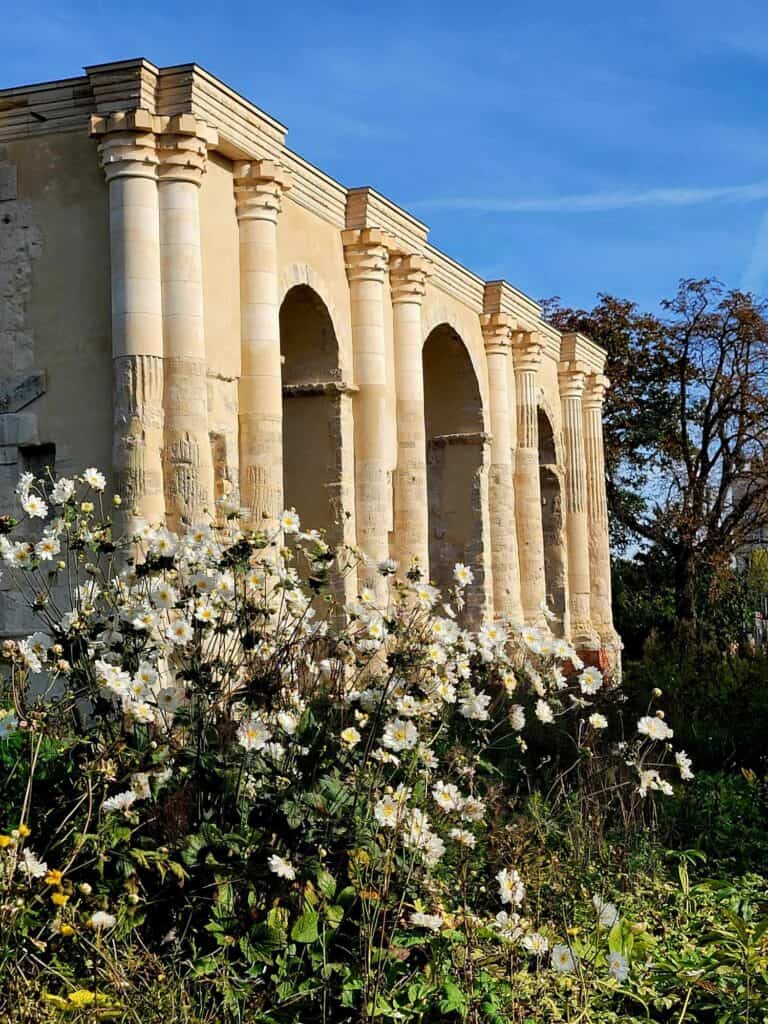
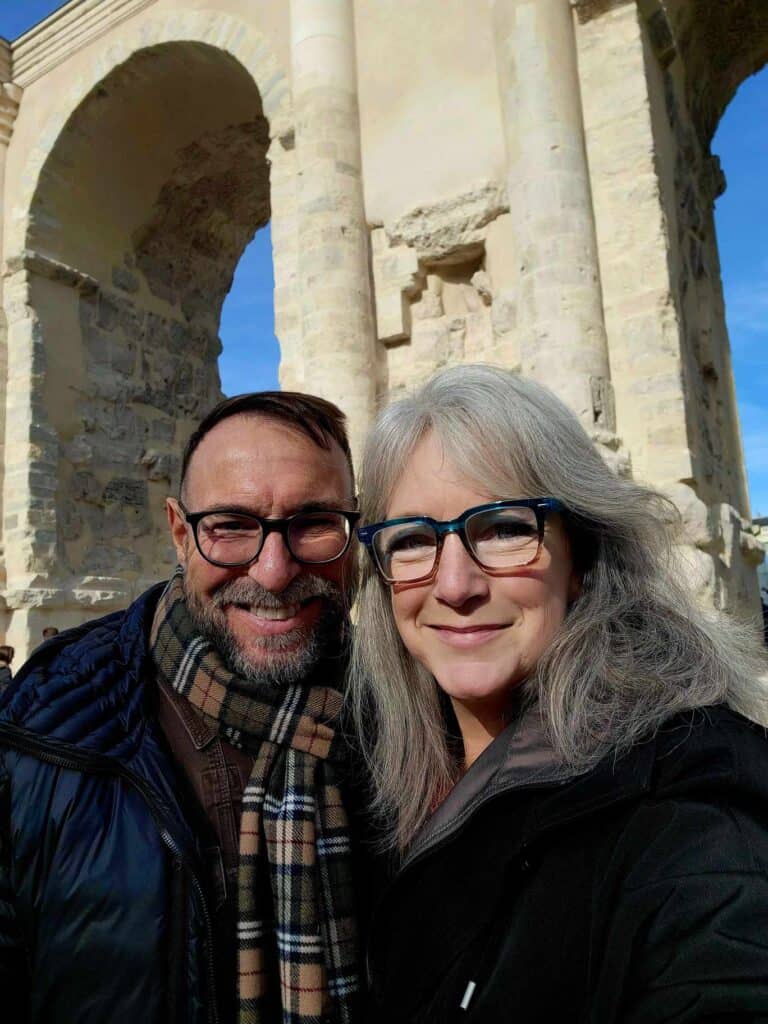
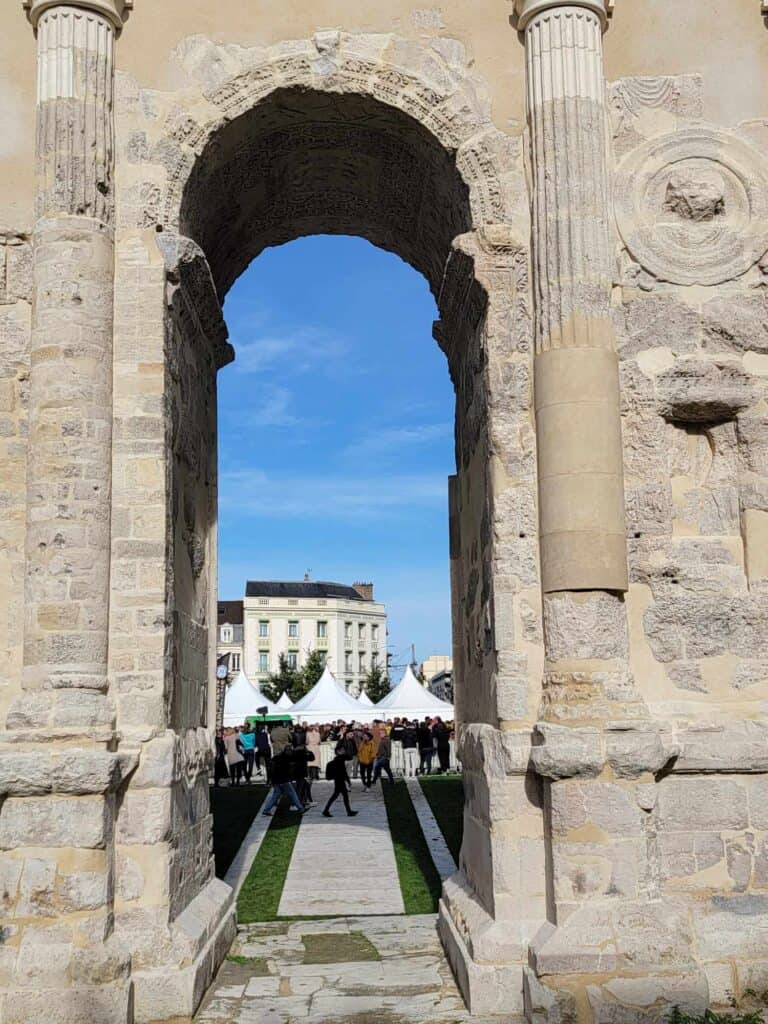
One of the easiest and best things to do in Reims is to stroll through the Mars Gate (Porte de Mars), a monumental Roman triumphal arch, and one of the oldest surviving structures in the city!
You might not have been expecting to see a ginormous Roman arch just hanging out in the middle of the city, but there it is! It was originally part of the city’s defensive walls and was constructed in the 3rd Century when Reims was called Durocortorum. You may think this sounds like a Latin name, but it is actually Celtic and means “fortified place of the assembly.”
Named after Mars, the Roman god of war, this last surviving gate was one of four, and symbolized protection, and the strength of the city.
It is actually one of the largest surviving Roman arches in the world! It stands at 105 feet (32 meters) wide, and 43 feet (13 meters) tall! The monumental gate has survived invasions, wars, and urban development, making it an extremely rare example of Roman architecture in northern France.
During the medieval period, the gate was buried and incorporated into the city walls, which actually helped to preserve it! Today, the unburied Mars Gate has been designated a national “Monument Historique.”
It really is impressive, and in the summertime it’s surrounded by flowers and green grass in a beautiful park, and is the perfect spot to relax, take a breath, and soak it in.
There are signs in french explaining the history and significance of the arch.
5) Eat a Pink Cookie! (Biscuit Rose)
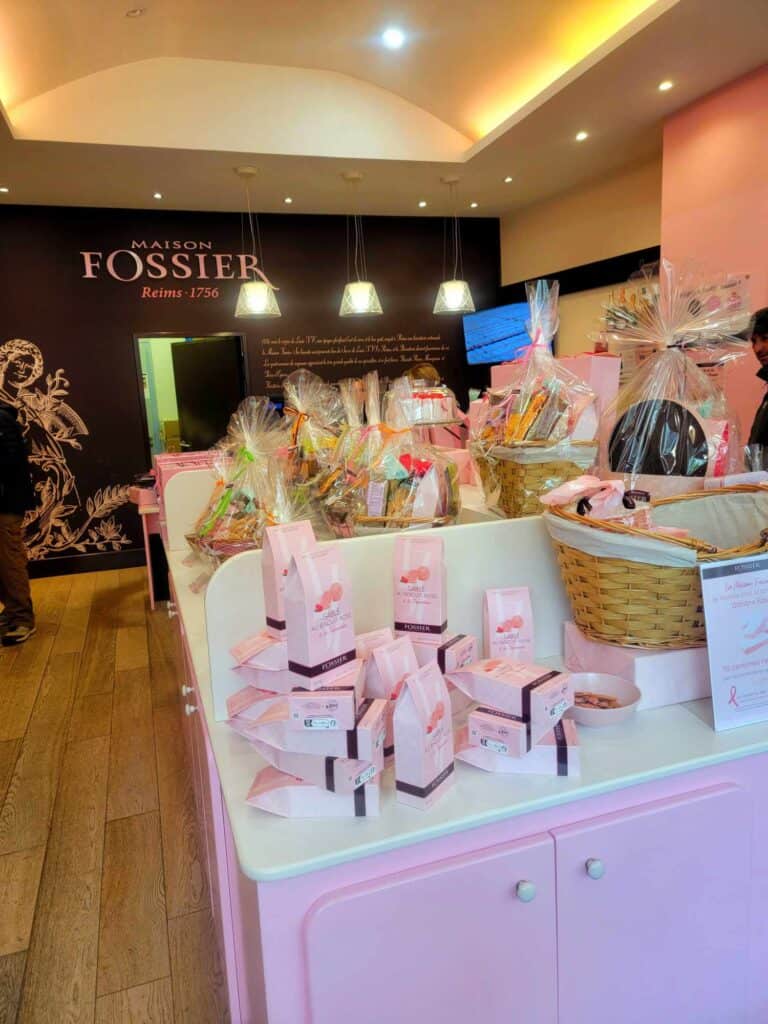
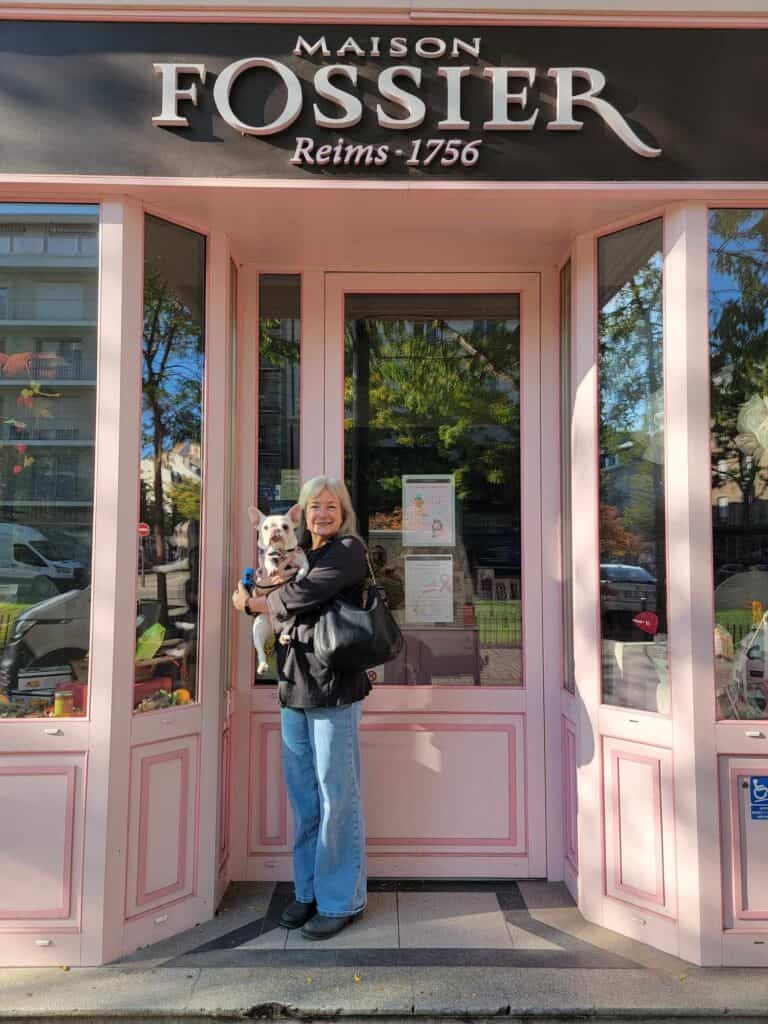
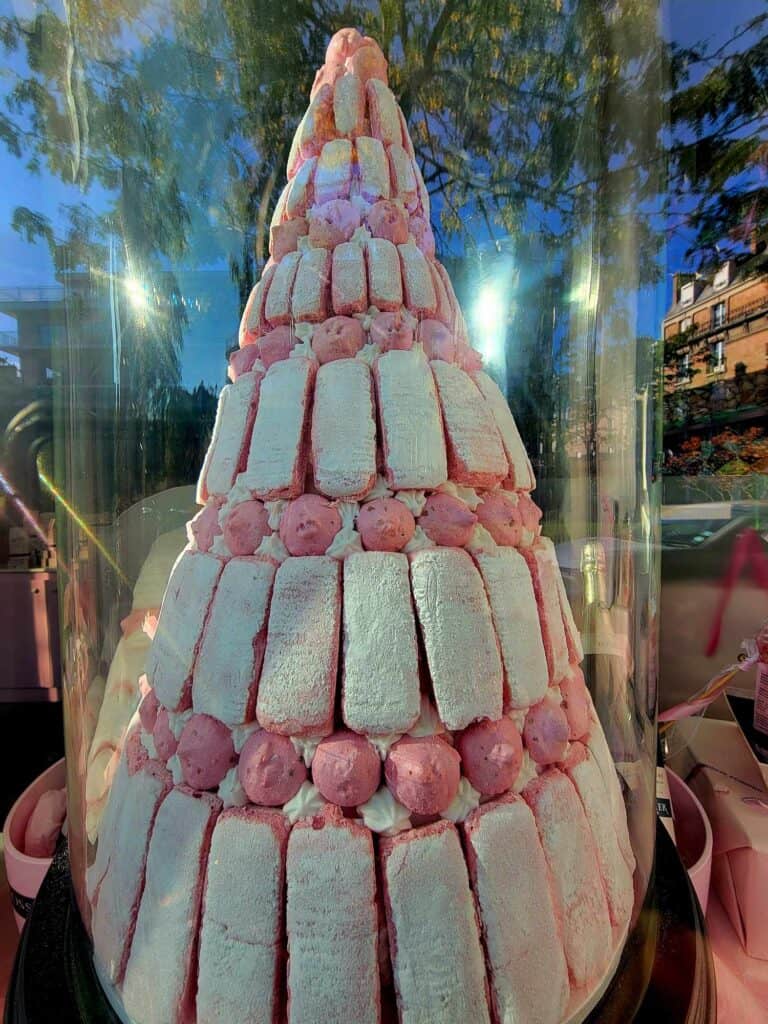
This isn’t just an arbitrary suggestion, it’s almost mandatory!
The biscuit rose (pink biscuit) of Reims is a beloved French treat with a history that dates back to the late 1600s! These light, airy, crispy biscuits are tasty and unique, and have become a symbol of Reims.
The first pink cookies
The first biscuit rose was created around 1691 by bakers in Reims who were looking to utilize the residual heat from their bread ovens. They developed a twice-cooked biscuit which baked in that residual heat. The biscuit rose is now emblematic of Reims and has survived for centuries as part of the city’s culinary tradition.
The unique pink color was introduced later, using natural carmine dye derived from cochineal insects. Yes, that’s right – insects. This red coloring made the biscuits visually striking and appealing for festive occasions. The insects were (and are still) used in a variety of applications like dying textiles, foods, medication, cosmetics, candies, and beverages.
What are they like?
The biscuits are rectangular, and crispy-crunchy but also delicate, and they melt in your mouth. Not too sweet, with a slight vanilla taste, they pair perfectly with… you guessed it… champagne! They are also fabulous dipped in coffee.
La Maison Fossier
The pink cookie became a specialty of the Maison Fossier, one of the oldest biscuit makers in France, founded in 1756.
Unbelievably, the Maison Fossier continues to produce biscuit roses to this day, using traditional methods, ensuring that the pink cookie tradition continues.
You can visit Maison Fossier’s flagship store and pick up a bag (or three) of biscuit roses to take home with you. It won’t be hard to spot because, yes, the building is pink!
They are also available in bakeries and gift shops, and we even had them offered at the breakfast buffet at our hotel.
They are used now, not just for dunking, but as an ingredient in tiramisu, trifles, and charlottes. Vive la biscuit rose!
6) La Petite Friande Chocolatier
15 Cours Jean-Baptiste Langlet, 51100 Reims
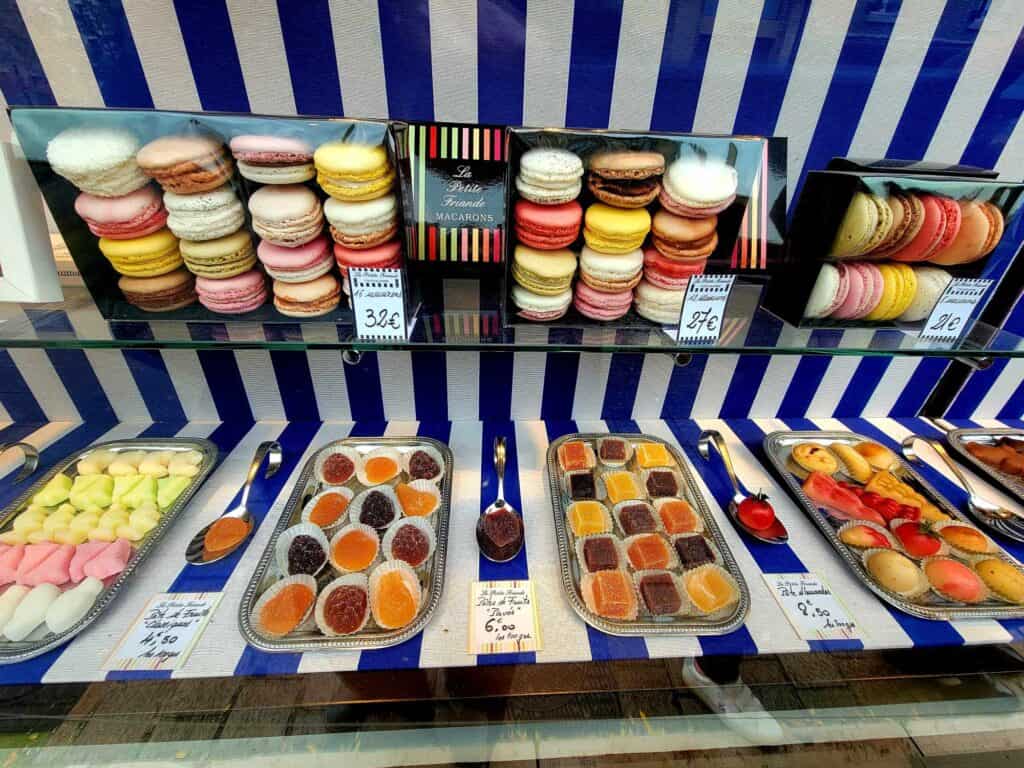
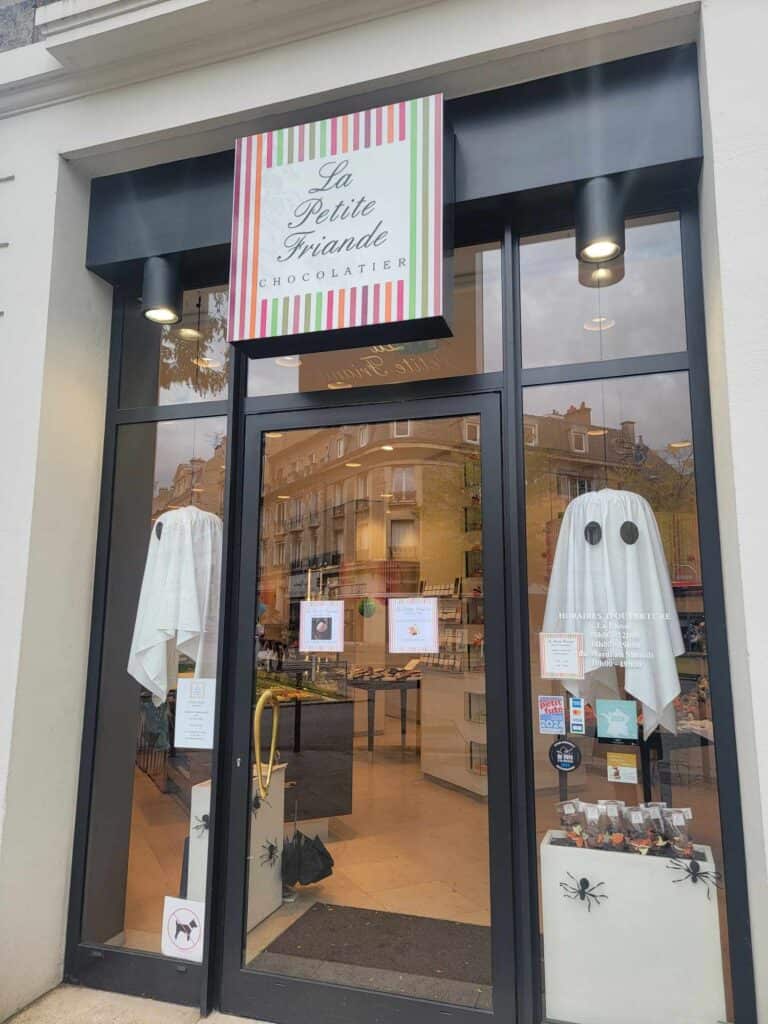
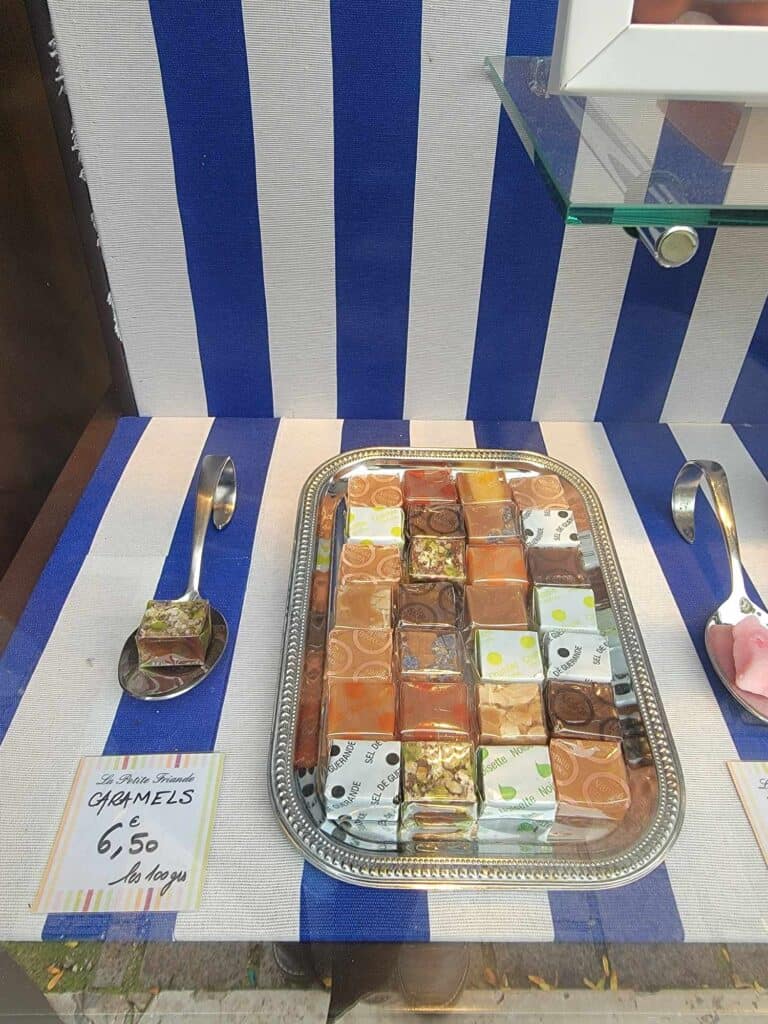
If you’re still in the mood for a sweet treat, I cannot recommend enough a stop at La Petite Friande Chocolatier. I’m actually kind of kicking myself that we didn’t load up the car!
What got us inside was the window displays. You know those stores that have food in the windows that make you want to smush your face into the glass? That’s this x 10!
La Petite Friande is a distinguished chocolatier and confectioner dating back to 1832! They’ve been at this a long time and it shows. If you are a chocolate connoisseur, do not miss this place. Their work is visually stunning, all handmade, and absolutely scrumptious. There are chocolates, macarons, caramels, and a whole range of creative sweets.
Make sure you fit them into your schedule.
- Monday: 10:00 AM – 12:00 PM, 2:00 PM – 7:00 PM
- Tuesday to Saturday: 10:00 AM – 7:00 PM
- Sunday: Closed
7) Saint-Remi Basilica
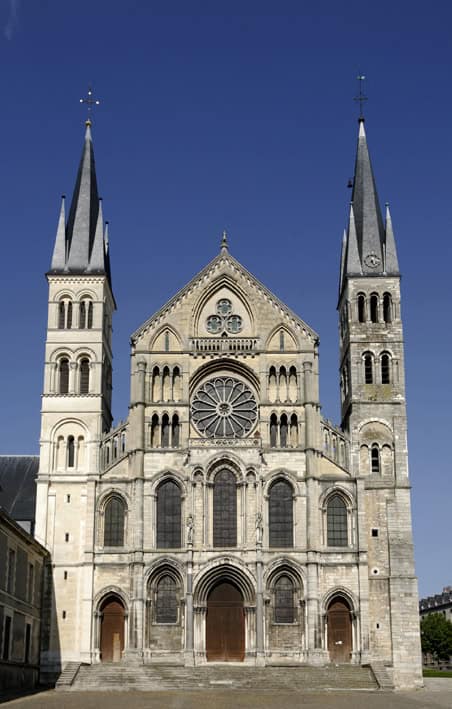
Reims, Basilique Saint-Remi-PM 14150 by Paul M.R. Maeyaert – 2011 – PMR Maeyaert, Belgium – CC BY-SA.
The Basilica of St. Remi is a stunning Romanesque-Gothic church that houses the relics of Saint Remigius. It is one of the oldest major landmarks in the city and is a UNESCO World Heritage Site.
History of the Basilica of St. Remi
The church was originally built in the 11th century, starting in 1028, to house the relics of St. Remi, the bishop of Reims who famously baptized Clovis I, the first King of the Franks on the site of the cathedral.
The relics of St. Remi are still there, and you can find them under the church in the crypt. This association with one of the most important saints in French history makes this an important religious and historic site.
Renovations and Preservation
The basilica underwent a major restoration in the 19th century to preserve its structure which was deteriorating. Today, it remains a place of active worship as well as a popular tourist destination for anyone seeking a glimpse into the religious and architectural history of Reims.
Be sure to visit the Musée Saint-Remi located adjacent to the Basilica in the former Saint-Remi Abbey. This museum focuses on the history of the region, including its Gallo-Roman roots, and also contains many medieval artifacts!
Admission to the basilica is free, but you are encouraged to make a donation to contribute to its maintenance. If you take a special tour or attend a special event, you may need to buy a ticket.
8) Villa Demoiselle (Villa of the Dragonfly)
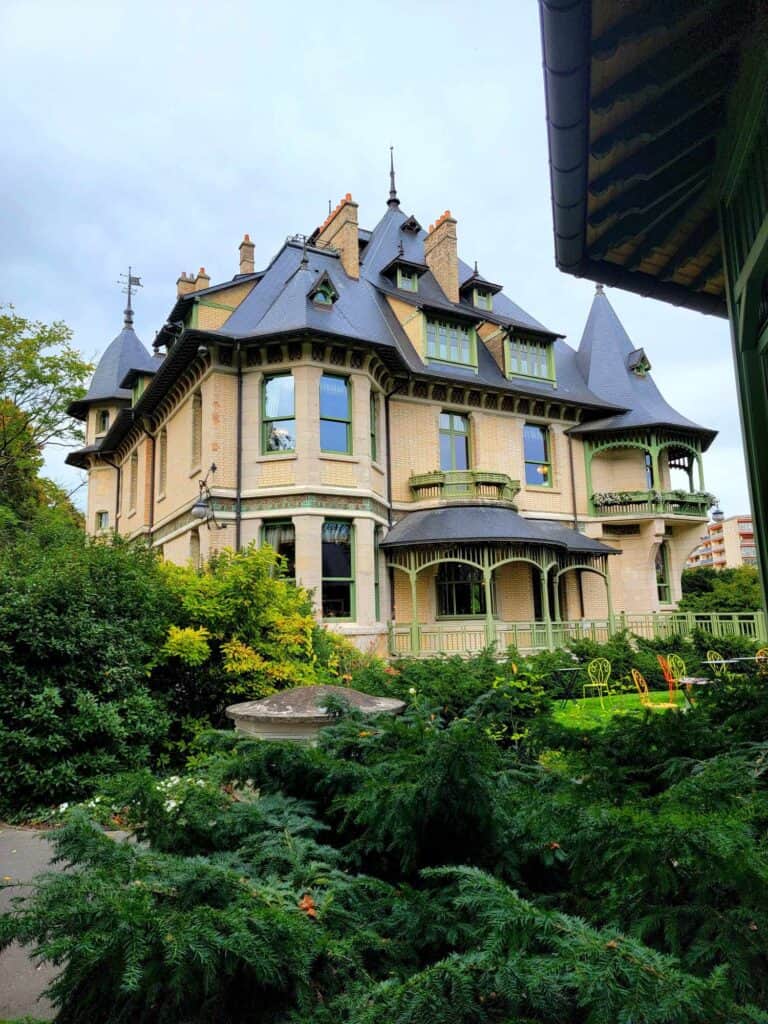
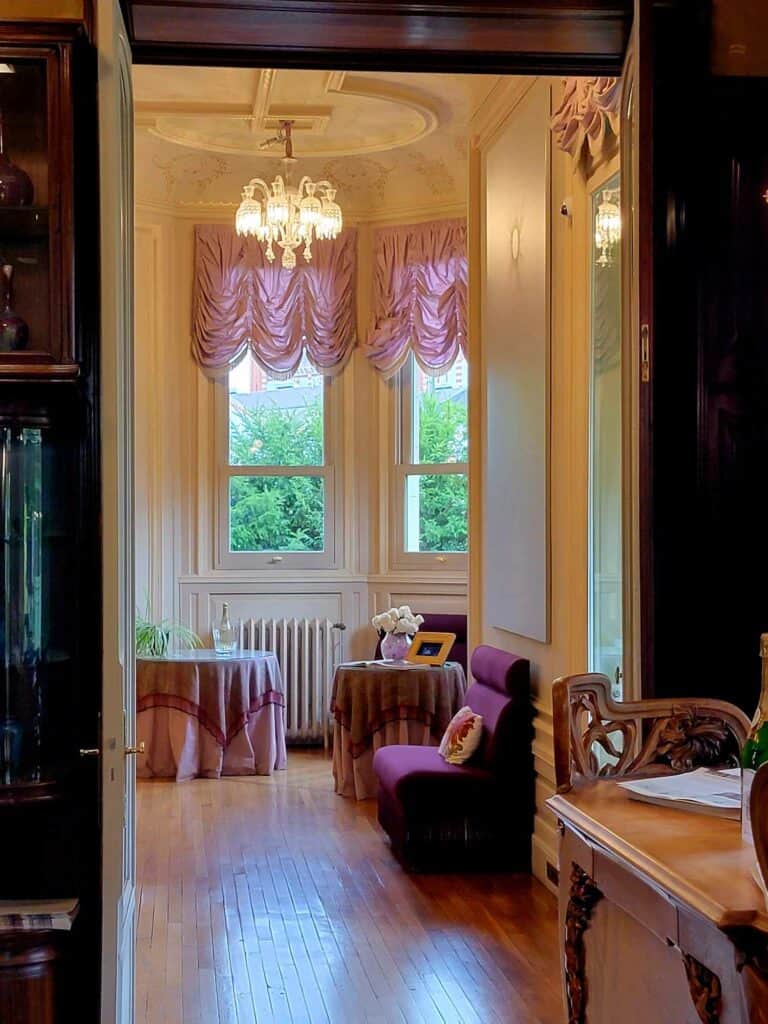
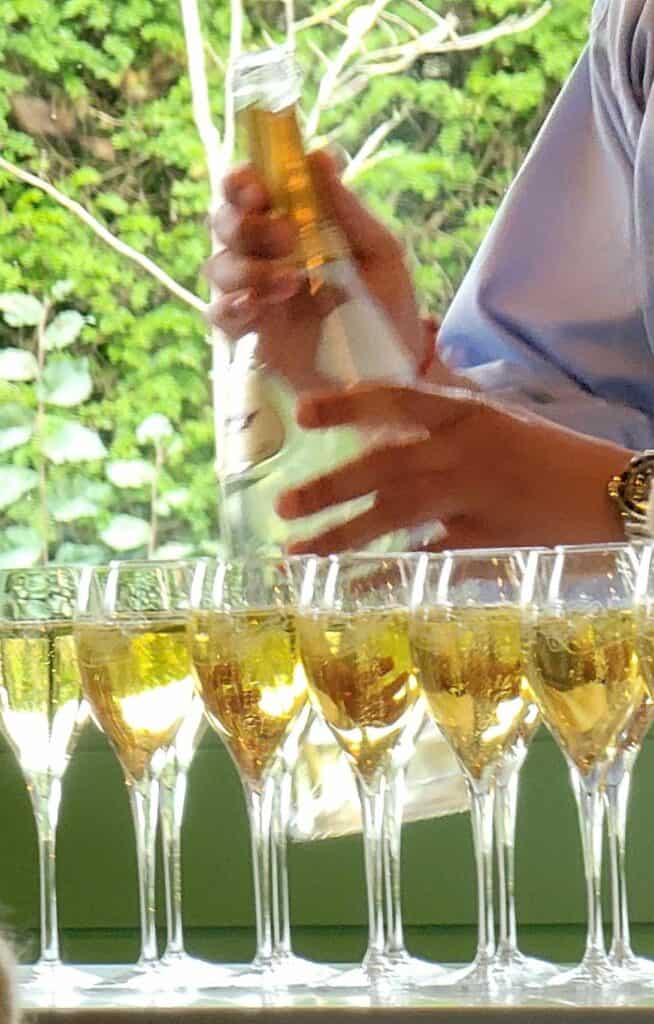
Villa Demoiselle is an absolutely gorgeous example of early 20th-century Art Nouveau architecture and design, with a dash of Art Deco thrown in. After meticulous restoration by the Vranken family who were affiliated with the Pommery Champagne House, it now offers guided and self-guided tours, often complemented by champagne tastings.
The whole time I was in this house I had fantasies about hiding under a bed and waiting until everyone left to pretend it was mine! It was absolutely sumptuous, warm and cozy, elegant, and beautiful from ceiling to floor. The furniture, the artwork, the staircase, the stained glass, the wallpaper… all took my breath away.
We visited with a guide that was included in our visit and tour of the Pommery Champagne House and Cellars. Especially if you are pressed for time, this is a great way to check off two incredible things off your Best Things to Do in Reims list!
Definitely book this English language tour well in advance if you have your heart set on it, especially if you are traveling during peak season. It often sells out, and I understand why!
There’s also a little gift shop where you can buy champagne and champagne related items. We loved the Diamant champagne we had at our tasting and even bought a bottle in the gift shop. It’s still waiting for that perfect occasion, and I can’t wait!!
9) Wander the City Center
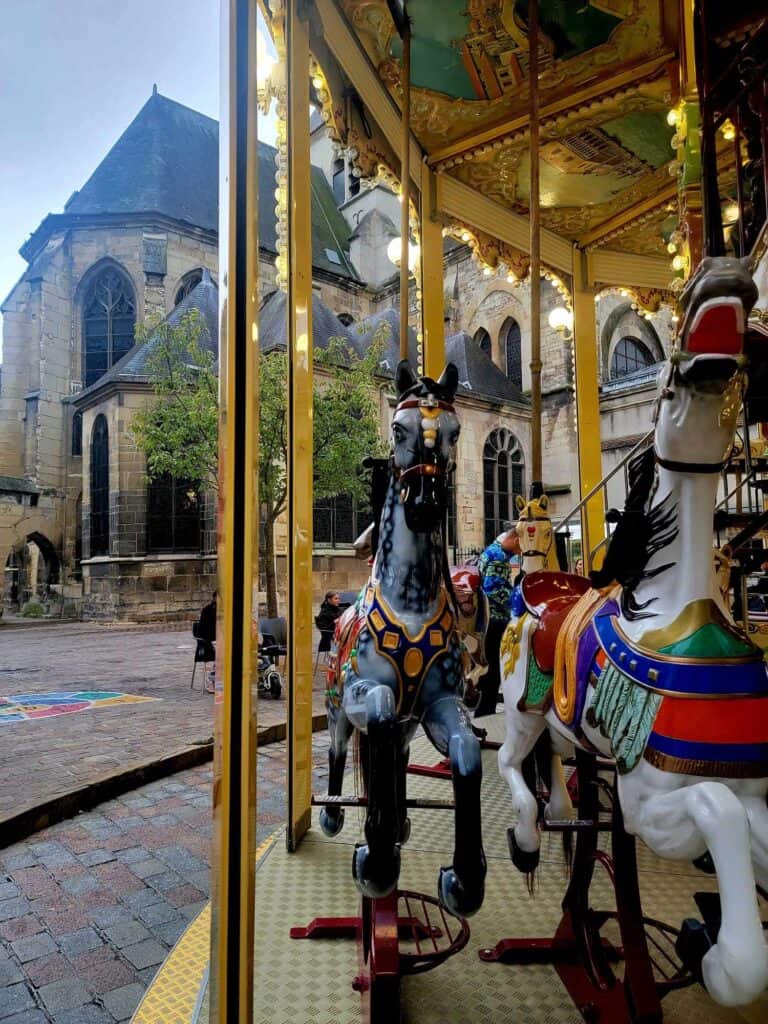
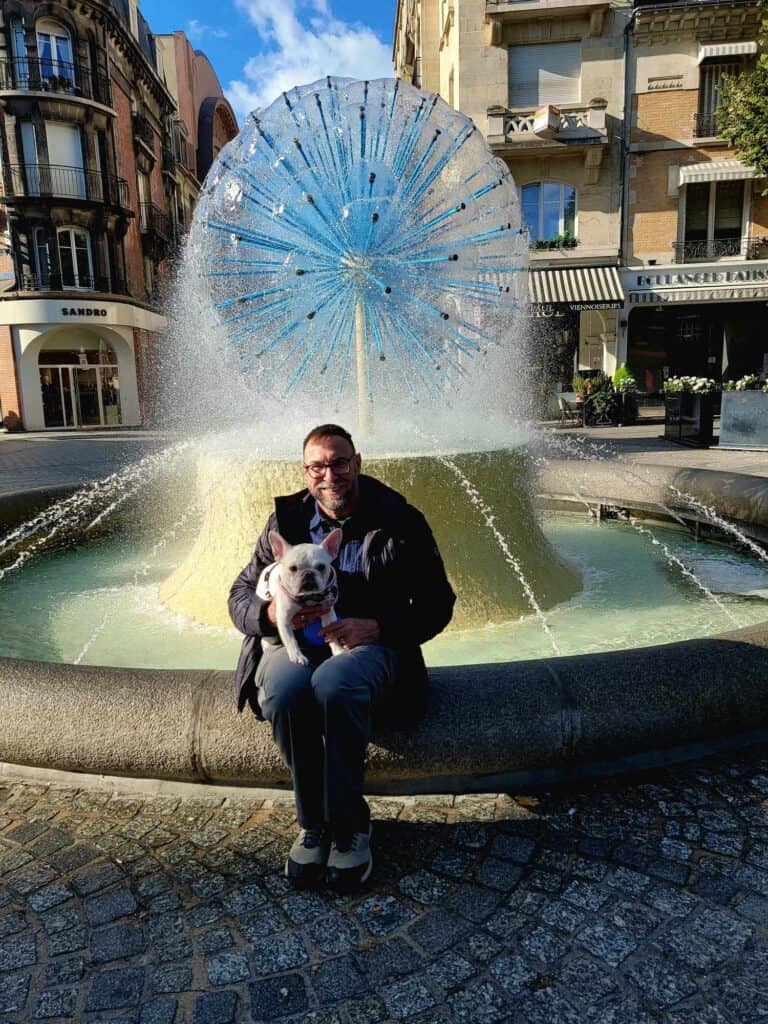
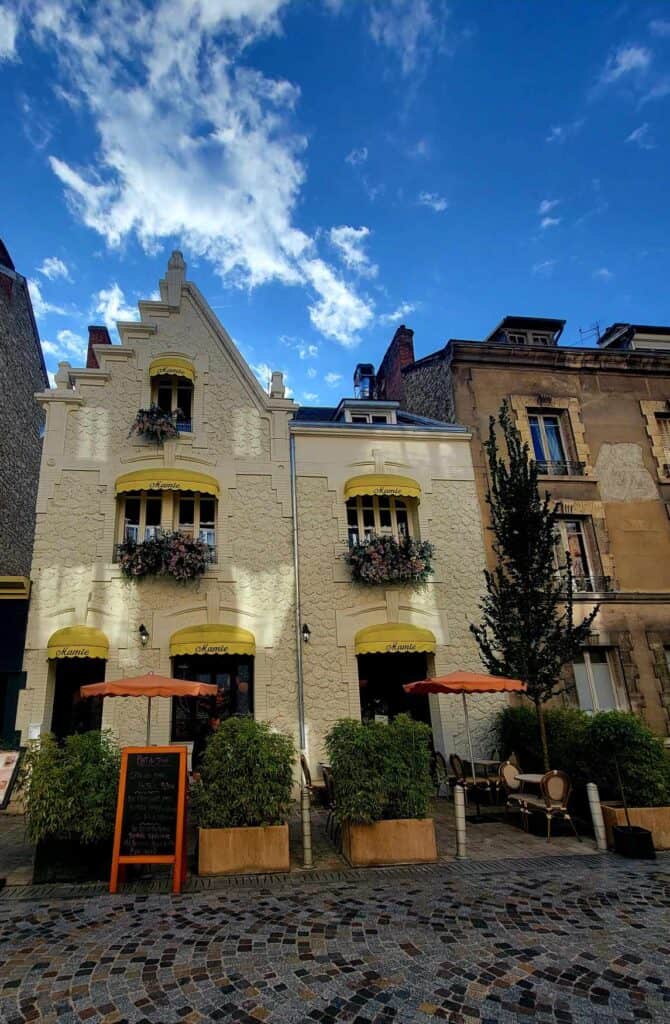
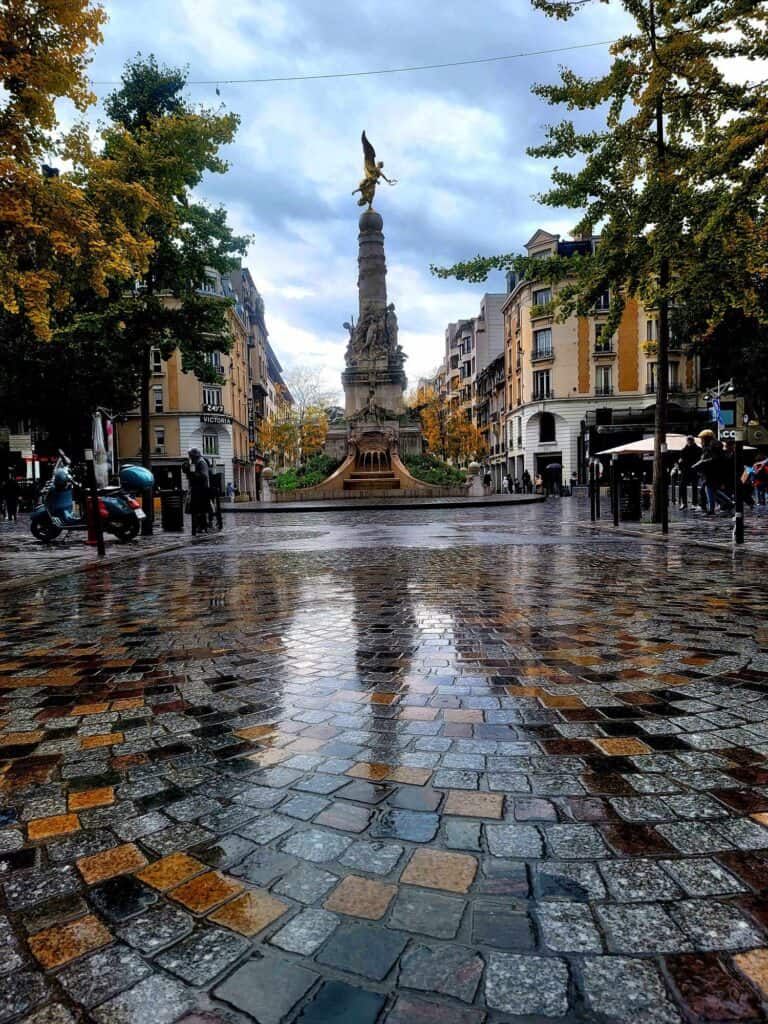

I always include free time to wander in my itineraries, especially in beautiful and elegant cities like Reims. Give yourself a few unstructured hours to just sit by fountains, peek in shop windows, have a spontaneous cup of coffee or champagne, browse antiques, and just explore and admire the aesthetic of the buildings and the city itself.
10) The Palace of Tau (Palais du Tau) and Future Musée des Sacres
2 Place du Cardinal Luçon
No list of best things to do in Reims would be complete without the Palais du Tau, but there’s a catch…
Renovation and Reopening Plans
Other than the cathedral, this site was high on my list of things I wanted to do in Reims. But sadly, my plans were thwarted! Extensive renovations have been ongoing since 2020, and the palace was still closed when I visited in 2024. I was really excited to head back to Reims in the spring of 2025 when they had announced a reopening as the Musée des Sacres. I’ve been checking their website pretty relentlessly, and I actually saw it change almost in real time from a message saying “See you in 2025!” to one that read “See you in 2026.” *sigh*
History and Importance of the Palais du Tau
The Palais du Tau was originally built in the 6th century as the residence of the bishops of Reims. But as with most buildings of that age, it has been renovated, expanded and reinvented over the centuries.
The palace housed the french kings during the times surrounding their coronations, and is located close to the cathedral where it all happened.
In the 12th century it became a Romanesque-style episcopal palace, and further renovations occurred in the 15th and 17th century. Today the palace has a distinctly Baroque feel to it from its last renovation.
The name “Tau,” interestingly, is not french at all but refers to the palace’s original T-shaped layout, which resembled the Greek letter Tau (Τ).
What’s in the Museum?
The contents of the Palais (soon to be called the Musée des Sacres/Coronation Museum) is absolutely filled with incredible treasures! When it reopens you’ll be able to see:
A Charlemagne Reliquary
This 9th century guilded reliquary is said to contain relics of Charlemagne, the first Holy Roman Emperor. If Charlemagne reliquaries are something that you really want to see, the good news is you can find some in the Treasury of the Cathedral of Aachen in Germany to tide you over!
Coronation Regalia
- In the collection you’ll find a 15th-century royal crown, which is the only surviving crown of the ‘ancien régime,’ that was used in the coronation ceremonies of French kings!
- Other items you’ll see will include the ampulla (a small vial) that held the holy oil used for anointing kings. Legend says it was brought down from the sky by a dove during the baptism of Clovis, the first King of the Franks. You decide.
Tapestries of the Life of the Virgin Mary
- They somehow managed to save a stunning series of 16th-century tapestries depicting scenes from the life of the Virgin Mary. These tapestries were part of the cathedral’s original decorations and survived World War I and the fire before being moved here.
Statues from Reims Cathedral
- There are many salvaged statues, including fragments of the famous Smiling Angel, which were damaged during World War I and later replaced by copies. There are also other sculptures including kings, apostles, and gargoyles that used to decorate the cathedral’s facade.
Treasures of the Cathedral
- There are scores of other fascinating objects including chalices, reliquaries, gilt processional objects and liturgical items from the cathedral.
Hopefully you will be able to experience all this for yourself. I know I have my calendar marked for 2026, and hopefully I won’t get another delay message!
Check the museum’s website to find out if they are open yet.
Other Cool Museums in Reims:
🏺Musée des Beaux-Arts 8 Rue Chanzy, Reims
This fine arts museum houses a collection of paintings, sculptures, musical instruments, and drawings from the 16th to the 20th century, including works by artists such as Cranach, Corot, and Monet.
🏠 Musée-Hôtel Le Vergeur 36 Place du Forum, Reims
This unique museum is located in a 16th-century mansion! It showcases decorative arts, furniture, and rare engravings including a complete set of Dürer’s Apocalypse series.
🇫🇷 Musée du Fort de la Pompelle Chemin de la Croix Blanche, Reims
A military museum located in a historic military fort situated just outside Reims. This museum is dedicated to World War I, featuring artifacts, uniforms, and weapons.
🥂 Musée de la Vigne et du Vin de Champagne Rue du Moulin, 51360 Verzenay
Located on the outskirts of Reims in Verzenay, this museum is housed in a historic windmill and focuses on the champagne-making process and the history of viticulture in the region.
🚗 Musée Automobile Reims-Champagne 84 Avenue Georges Clemenceau, 51100 Reims
This museum features a collection of over 230 vintage cars, motorbikes, and other vehicles, spanning more than a century of automotive history, including rare and classic French cars, including models from Renault, Peugeot, and Citroën.
Where to Eat in Reims
Canard Street
3 Marx Dormoy, Reims
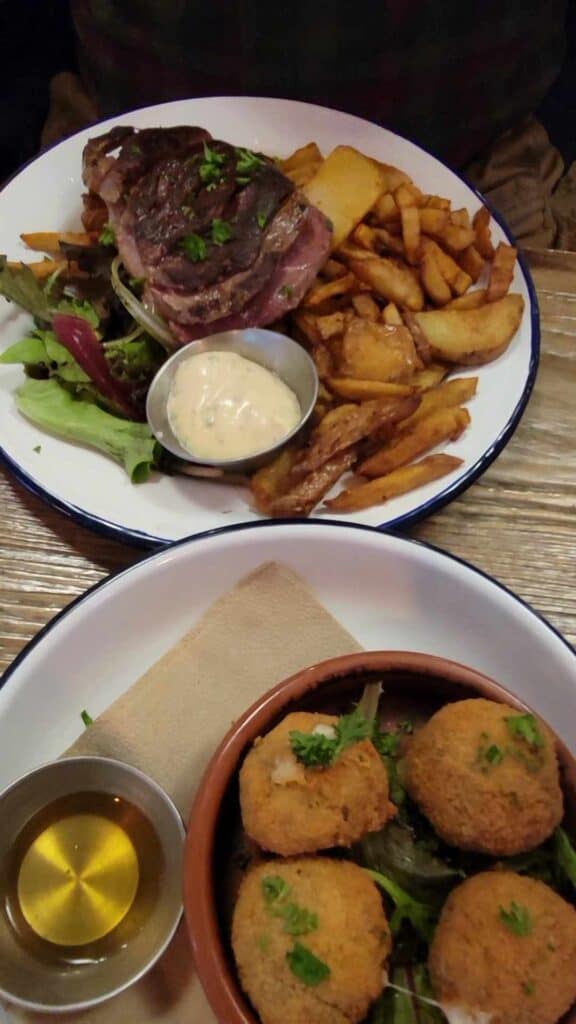
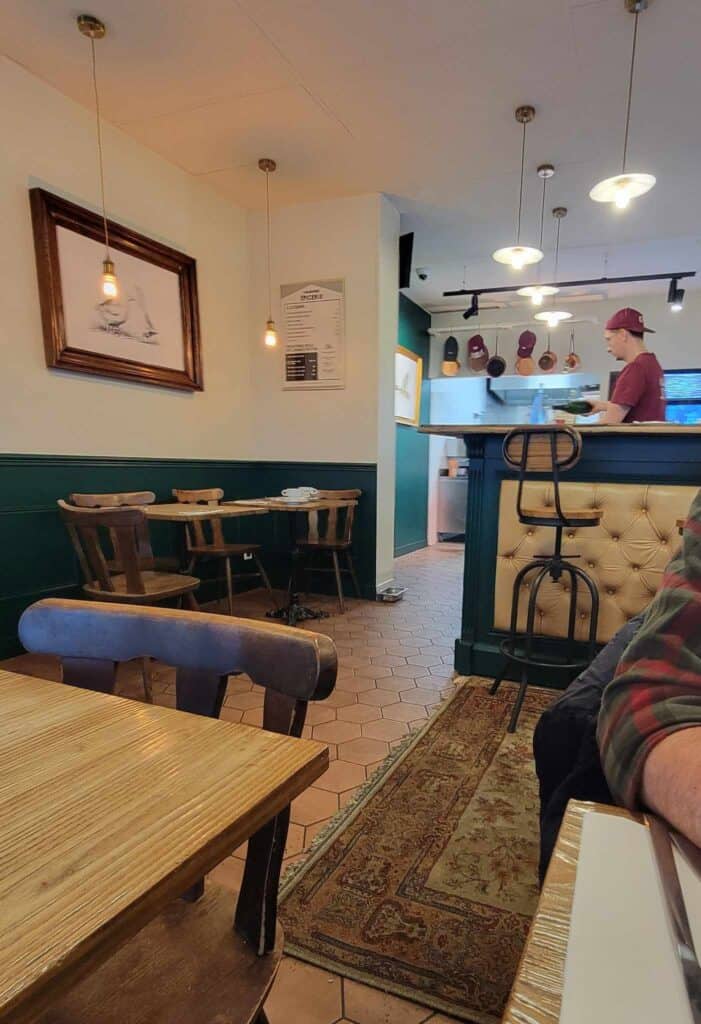
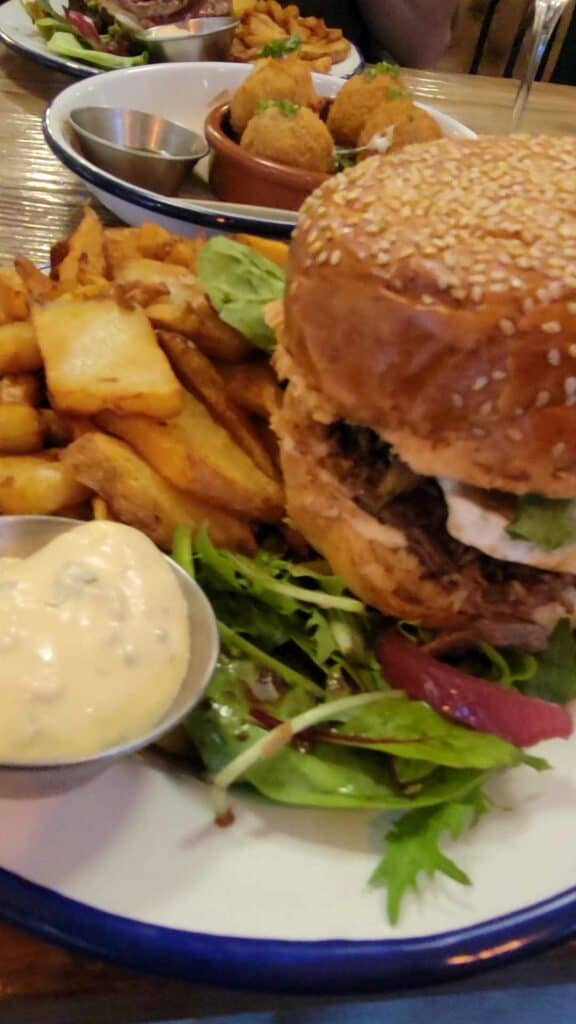
For a casual dining experience that feels like a luxury, you must check out Canard Street. It means “Duck Street” and the menu, as you might have guessed, is all about the duck. And I’m talking the most deeply flavorful, juicy not greasy, melt-in-your-mouth, I’m-still-dreaming-about-it duck you’ve ever had.
We started out with the duck croquettes, and then I had the duck confit burger, and my husband had the duck breast. It was rapturous, and I was sad when I got full because my mouth wanted to keep going!
This place was perfect for a big lunch after a morning of tramping all over the city.
L’Apostrophe
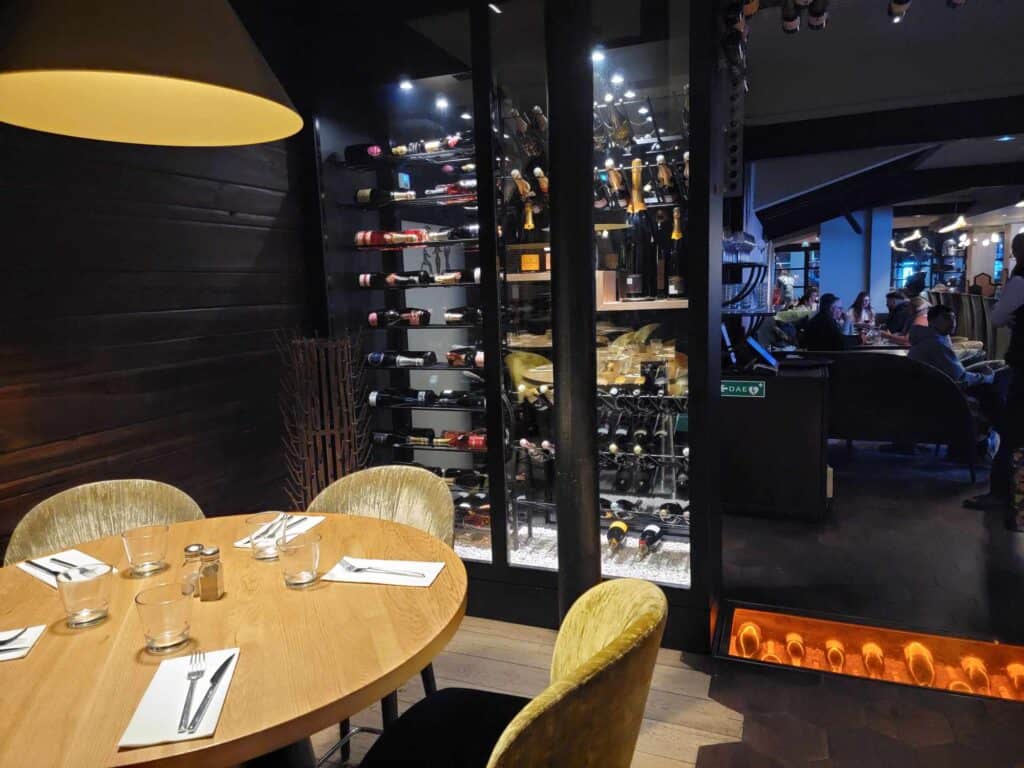
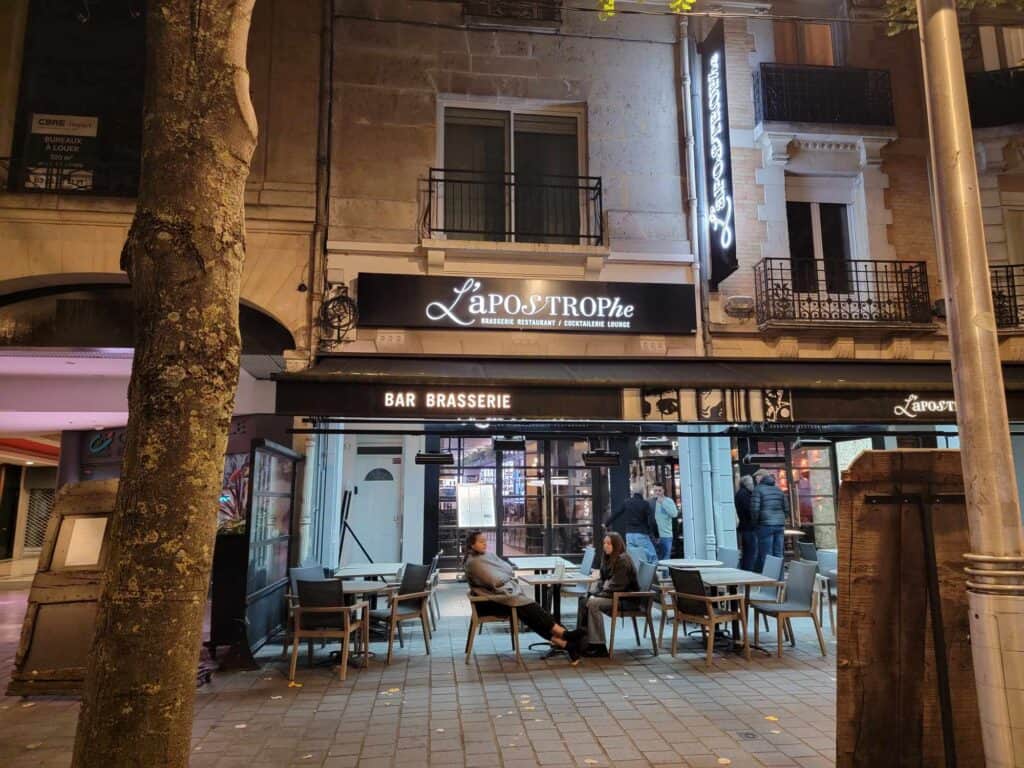
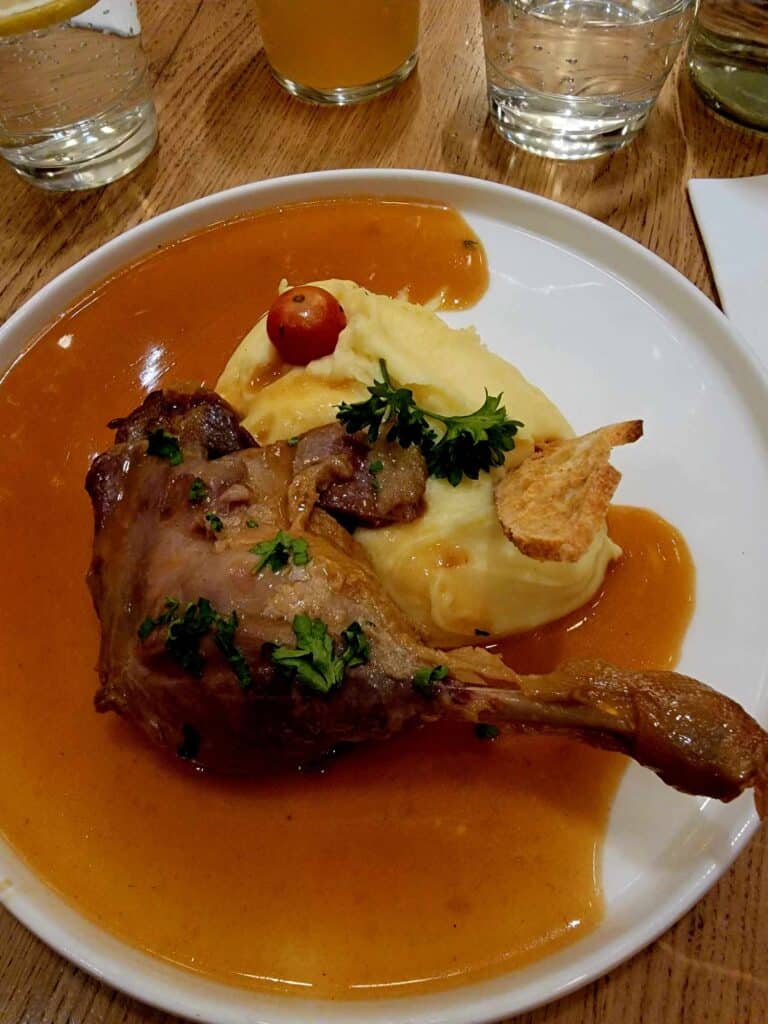
A lovely dinner spot which I’d categorize as “business casual” is L’Apostrophe. The atmosphere was moody and modern with a wine motif, and we managed to get a table without a reservation, although we were sitting way in the back which had a different vibe to it.
I got the duck again, because… France! The duck confit was excellent, as was my husband’s creamy pasta with ham. We shared some kind of chocolate lava cake for dessert which was decadent, and the perfect way to end the meal.
I definitely recommend making reservations here. I think the only reason we got a table is because it was very early by french standards. By the time we left it was packed!
Where to Stay in Reims

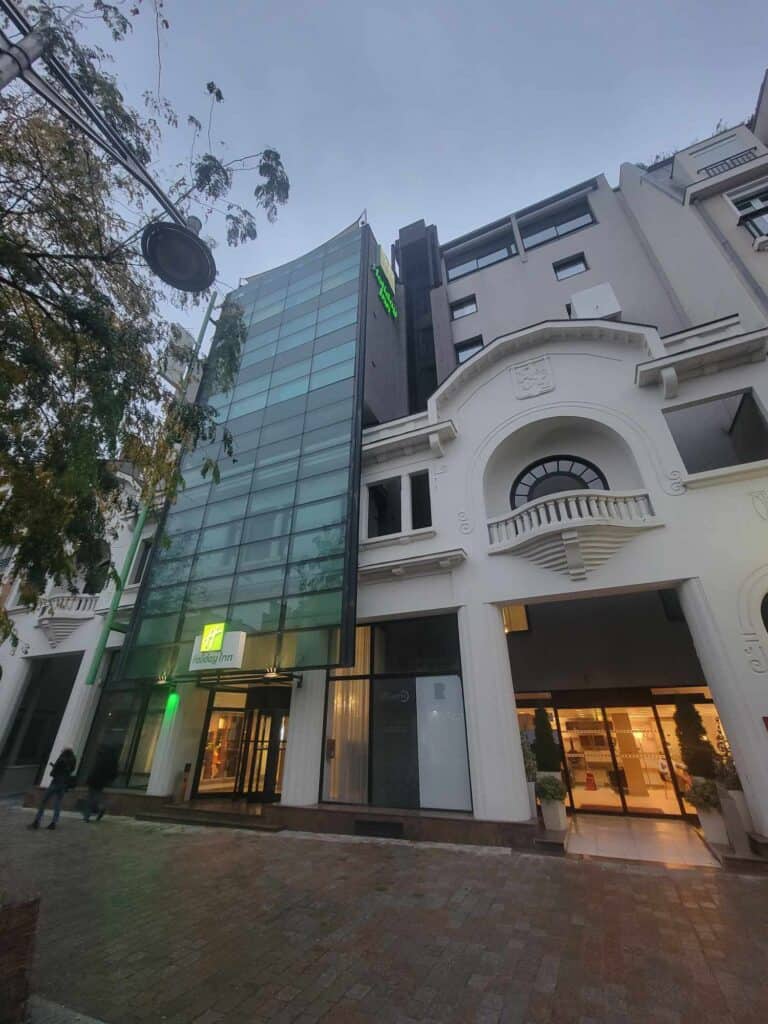
We always need a dog-friendly hotel room for our traveling companion Helga the Frenchie, and we also needed somewhere with parking since we drove there, and a place that was close to the things we wanted to see. We ended up staying at the Holiday Inn Reims and it checked all the boxes!
The staff was incredibly friendly and helpful, the breakfast buffet was on point (including pink cookies!), and our room was clean, and well appointed. The fridge came in handy to keep our champagne, cheese, and other goodies cold!
And yes there was parking on site, to include something we’ve never experienced before… a car elevator! It took us a minute to realize what we needed to do, but eventually we figured it out. It was definitely strange driving into and backing out of a gigantic elevator, but I actually liked it better than some of those spiral things you have to navigate.
There is also apparently a beautiful rooftop restaurant, but sadly renovations were underway when we were there, so we’ll have to wait until next time.
All in all, our experience was great and we would definitely stay again, and Helga approved too!
How to Get to Reims
By Car
From Paris: About 1.5 hours
From Brussels: About 3 hours
From Luxembourg: About 2 hours 15 minutes
From Strasbourg: About 3 hours 15 minutes
From Kaiserslautern: About 3 hours
By Train
From Paris: About an hour
From Brussels: About 1.5 hours
From Luxembourg: About 1 hour 20 minutes
From Strasbourg: About 2 hours 15 minutes
From Kaiserslautern: About 4 hours
I hope you have a great time exploring all the best things to do in Reims – treading in the footsteps of kings, enjoying the very finest champagne, standing in the shadow of ancient Rome, and taking full advantage of the culinary delights that await you!
You Mat Also Like:
Hack the Louvre! How to visit the Louvre in 3 hours
Napoleon’s Tomb is Definitely Not What You’re Expecting
Is Versailles Worth It? Bastille Day in France
What to Expect at the New Museum of Urban and Street Art in Bitche
12 Incredible Things to See in Metz, France
